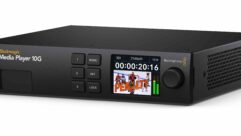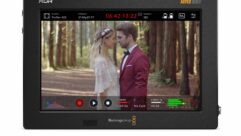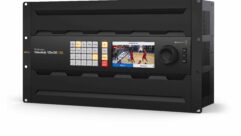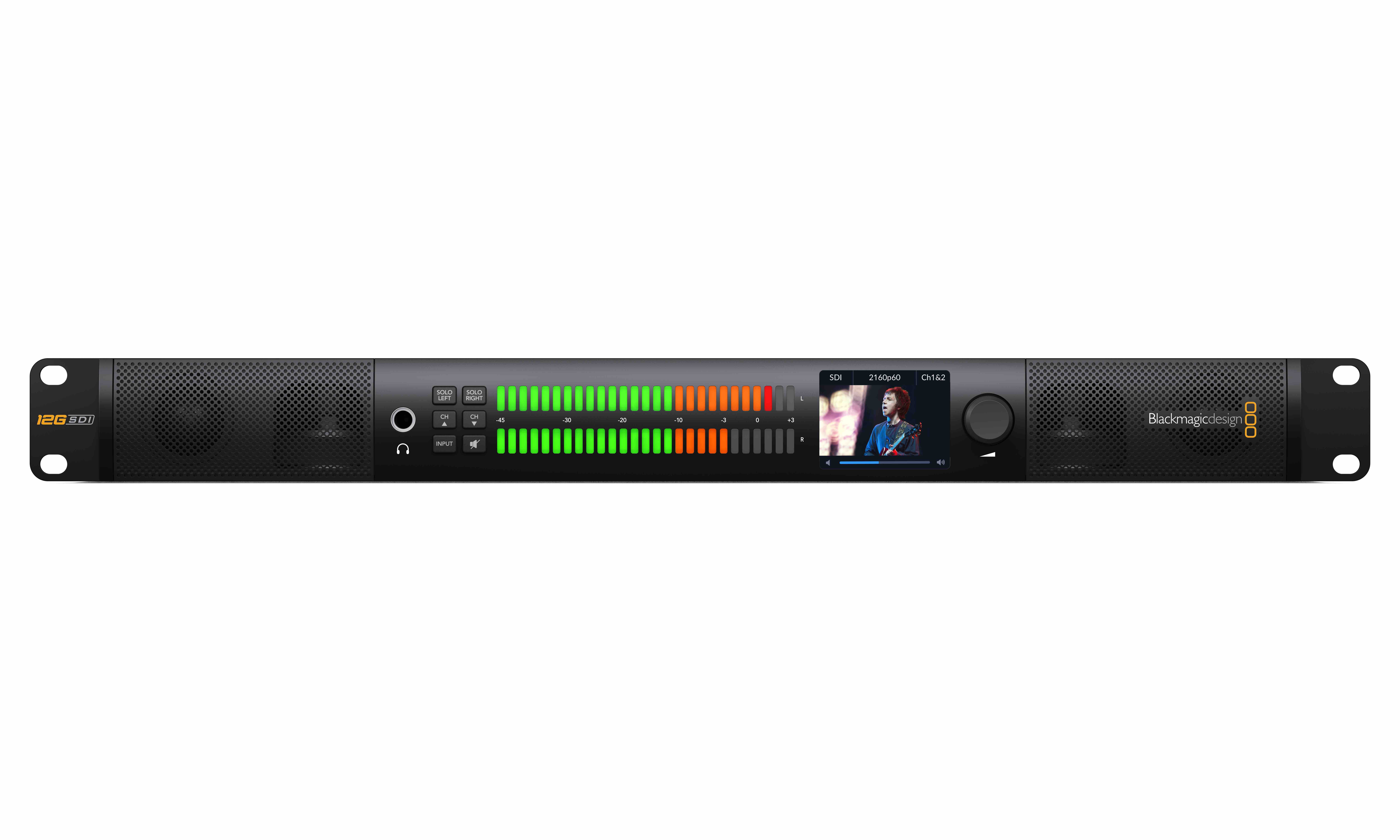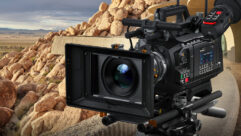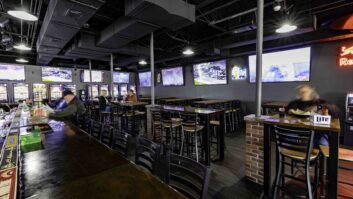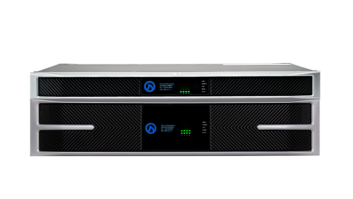On this edition of the SVC Podcast, Contributing Editor Bennett Liles talks with Ricky Perinchief of Proton Global Media Group about the recent video upgrades for NOW Church in Ocala, Florida featuring cameras and video transmission gear from Blackmagic Design. Ricky explains how the new equipment makes it easier for the multicultural church and its volunteer tech crew to get the word out to a global audience.
Links of Interest:
· URSA Broadcast professional broadcast camera
· Blackmagic Micro Studio Camera 4K
· Teradec Bolt wireless video system
This is the SVC Podcast from Sound & Video Contractor with Ricky Perinchief of Proton Global Media Group. Show notes and product links for all of the SVC podcasts are at svconline.com. See the Podcasts link at the top of the page.
Small churches can now have a very big media reach but selecting the right production gear can make a huge difference in getting the word out. In Ocala, Florida the NOW Church does that with ATEM switchers and cameras from Blackmagic Design. Ricky Perinchief of Proton Global Media Group installed them and he’s here to give us the story on the SVC Podcast.
Ricky, glad to have you joining us for the podcast from Proton Global Media Group in Ocala. Nice of you to get with us.
Thanks. Glad to be here. Appreciate it.
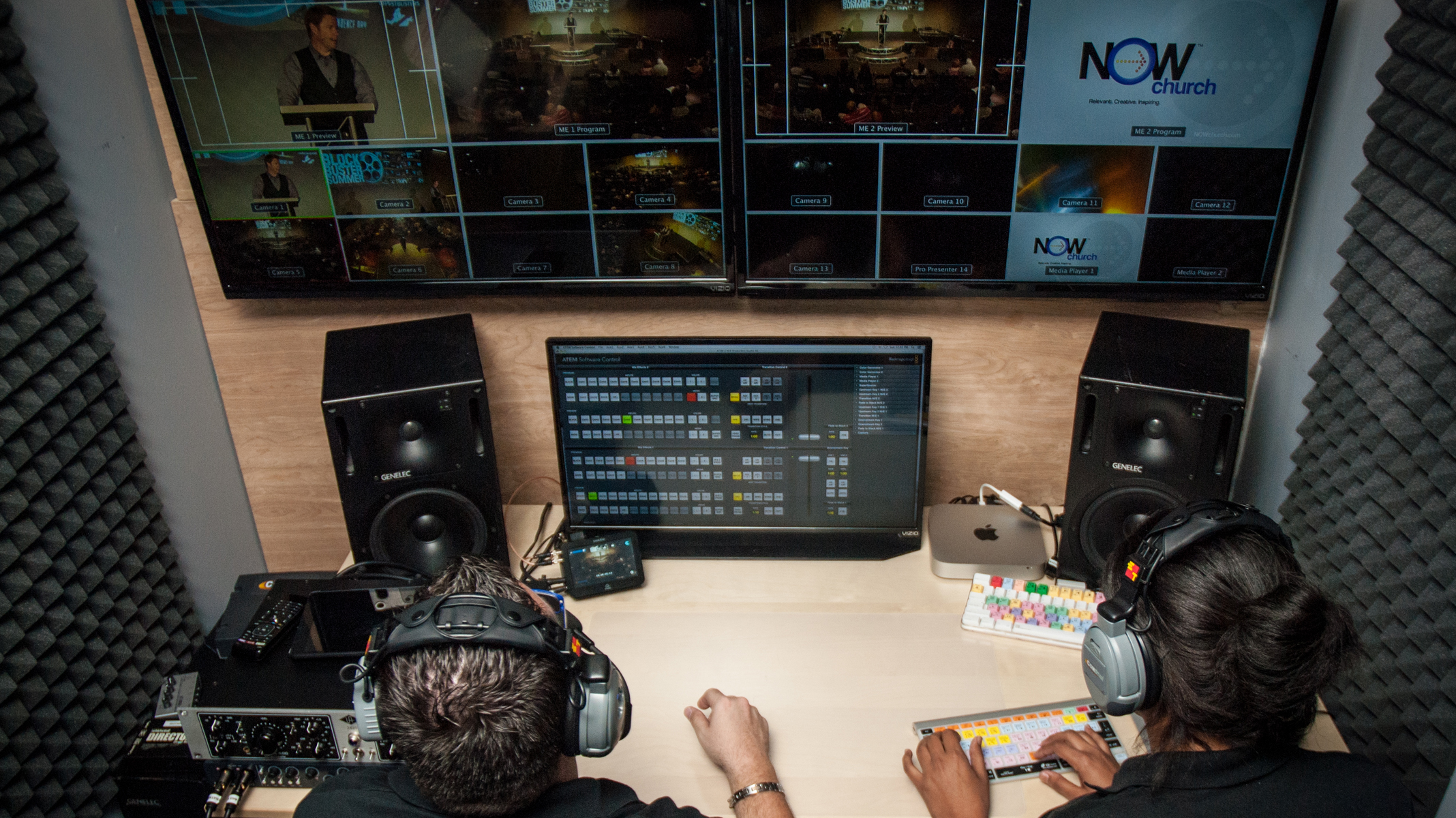
Well, tell us about Proton Global Media Group and yourself. You’ve had a lot of experience in the tech side of media production. Do you specialize in churches?
I do. That is correct. I started out – I’m a pastor’s son so I started out early on. In fact, my father, his first job in ministry back in the 80’s was actually at a local Christian television station in Orlando. So as a young kid, you know, six, seven, eight years old, I was around the control room. I was around cameras. Then after that he became an associate pastor at a large church in Orlando and they were on television. They were on national TV. After work, after school I would sit in the control room as my dad was working and just would watch them edit and watch them shoot and watch them produce and always had a knack for that. So then my dad then planted his own church, NOW Church here in Ocala, Florida, in 1990. And just growing up I was trying to find my own way in church and was able to get into the technology side at a young age; first in audio and then into video, which now is 20 years ago I started the church’s television ministry and it’s grown by leaps and bounds. Of course I’ve seen a lot of technology changes and things, but now with Proton Global I’ve been able to take all my production background that I’ve had working with Disney, Universal, Gov. Jeb Bush, Showtime, Universal Pictures, all these different things in my production career and have taken that knowledge of broadcasting and then taken that into how do I get that into church life and how can I take my experience and help churches to grow and help them to do something affordably and systematically? So that’s kind of what we do with Proton Global is consult and design and just really kind of test technology and review it and write about it and kind of see how things go. [Timestamp: 2:38]
Well, it’s not hard to see how you got into this then and how you’re doing this.
Absolutely.

Yes and you told us a little about the NOW Church. What kind of worship style do they have? Obviously, not the very straight and traditional type so how have they used AV technology sort of leading up to this latest upgrade you’ve done for them?
Sure. So NOW Church has always been a church that is really technologically advanced. I think my father being youth pastor first and really being somebody who really grew up in church as a teenager – and he was the kid who went to Sunday School, went to church because his parents dragged him, because it was more of a religious church back in that day and he just didn’t fit. So he would always sneak out and go out with his friends and do things during church and then come back in and his parents thought he was in children’s church the whole time – but he had snuck out. And so it wasn’t until he was a, I guess late teenager or early 20’s, that he actually found God and found Christianity and found a true relationship personally instead of just being under his parents and being made to go to church. And he did that by connecting to a church that was more nontraditional. And I think that is where all that upbringing with him has caused him to birth NOW Church where it’s something that’s very nontraditional. It’s really a lot geared towards the young and the young at heart. Being in Ocala, we’re actually about 30 minutes away, 25 minutes away from The Villages, which is one of the largest retirement communities in the country; one of the fastest-growing. And we have so many people come in from The Villages and they love our contemporary worship style. And they love being around the young and the young at heart. And also I think we’re a very multicultural church. Back in 1990 when we first started we started getting people of different color coming in and there was a lot of pressure back in that time, really even in Ocala more segregated as far as churches go. And really I think we pioneered, as a church, being able to have a multicultural, multigenerational church. And that’s something we really pride ourselves in. We’re not a black church. We’re not a white church. We’re not a Hispanic church. We’re not an Asian church. But we have so many people of different backgrounds and different ethnicities which make our church who we are, and I think bring a lot of those influences and flavors into what NOW church does in our worship experiences. [Timestamp: 4:50]
That’s a real challenge to span generations and make it interesting for the entire congregation especially in a multicultural environment. We know that you’re on social media but as far as the TV coverage goes, how does NOW Church get their signal out to a global audience?
We started out on our local ABC affiliate here in the Ocala and Gainesville area and had a long relationship with them as well as Super Channel 55, which is based in Orlando, which is a large Christian station here in Florida. Very big signal and eventually grew into satellite on in Europe and different places. And then, of course, with the transition of going from broadcast where it kind of merged with the whole internet and the internet generation and Apple TV and podcasting and everything, we’ve really grown and adapted and been able to get our services out even online as well and have that social media presence, which I think has really been interesting. Especially being in this industry 20 years. I remember going to NAB even 20 years ago where they were saying television and internet will be merging. There’s not going to be just an animal channel. There will not be just a dog channel. There will be specific content, like even a golden retriever channel. And 20 years ago we really didn’t know what that looked like. And I think now seeing where YouTube has gone, where the internet has gone, and where Apple TV and Amazon and Hulu and Netflix and all those things, you’re able to see well yes, absolutely, there’s room for everybody and there’s ways that you can distribute the content wherever people are. And they can get it on demand, they can get it live, and it’s something where you can reach different people groups a lot easier than you could and a lot cheaper than you could back when just television and radio were just the alternative. So it’s been an exciting transition. [Timestamp: 6:27]

You’ve certainly taken maximum advantage of the available technology and I think that having that much experience in the business and watching the technology evolve has been valuable. Blackmagic Design has been central to that and you recently added an URSA Broadcast Professional video camera. That’s a pretty advanced piece of equipment. You have a volunteer tech crew.
Yes.
So what’s the learning curve on that thing?
Well, you know, it’s not too bad especially because of the Blackmagic system. And really, we were early adaptors to all things Blackmagic. I kind of saw where they were headed, and of course even looking at NAB, even the last 15-20 years, all the marketing was done by the big boys – Sony, JVC, Panasonic, Cannon – all those things. You’d seen the banners everywhere. And now in the last five years or so you’ve seen Blackmagic really take over the helm and you see all these huge banners and all this advertising and this huge booth and the huge buzz that they’ve created. I think they’re bringing a group of products and just great research and development to be able to find out what clients are wanting, what customers are requesting and needing, and able to meet that in a budget-friendly way. And especially for churches with volunteers, most of us do run on a heavy volunteer presence. We can’t do what we do without them and we want to make sure that our technology can really make them shine and can really be easy for them to use and easy for them to learn. And I think what Blackmagic’s whole system, the way they’ve developed the ATEM switcher and the cameras and the way the camera control can be, and the template-driven type things, it’s very easy for volunteers to open up the template and run and operate this stuff without having to know really the major technical stuff that requires more book reading and more experience-type stuff. So somebody like me with Proton Global will come in and design a system and then go in and integrate and make sure everything is talking to each other and everything is set up the way it needs to be. And then to have the volunteers be able to just open up the templates and run with it, it’s just super easy and super user-friendly, which I think is why Blackmagic has grown in leaps and bounds. Specifically on the URSA Broadcast, we, of course, started with the first Blackmagic cinema camera years back when it first came out. We preordered it at NAB, in fact, and of course waited, I think, a year or over a year for it. Once it finally came out we just loved it and we said man, this is so user-friendly. It’s a product that is cost-effective. And when we’re looking at how to upgrade our studio cameras, that’s right around the time that the studio camera was coming out. So we ended up getting one of those studio camera HD’s from Blackmagic and we used it for quite a while. In fact, we just retired our last one just a few months ago before this URSA Broadcast we got. With the studio camera, the difference was it was not great in dynamic range. And of course, everybody and their mom asked me every week how do you get a B4 lens on the studio camera and how do you work with it in church? And really, that was a difficult question. I had people all over the world calling me, texting me, tweeting me, asking me. And I think Blackmagic heard those cries and I think with the URSA Broadcast they’ve really fixed a lot of the things that people are crying out for by releasing the first camera that is actual native B4 2/3-inch sensor that is not limited to just 1080p but can so do 4K. When those ultra HD lenses become more affordable and more the norm you’ll be prepared for it, which is great. So I think with the URSA Broadcast, with the dynamic range, with the sensor, the clarity you can get, I think it’s something where if they haven’t caught your attention yet I think the URSA Broadcast is something that will. [Timestamp: 9:47]
And you also use the Micro Studio Camera 4K’s.
Yes.
So how have you got those set up?
We have an URSA Mini Pro with the B4 adaptor, which is our Camera 1. Our URSA Broadcast is our Camera 2 and those are both on sticks. And then we also use the Micro Studio 4K’s just all around the room in different places, especially because they can control with the whole ATEM switcher and the whole camera control stuff from Blackmagic. We’re able to control the colors, the white balances and all of the settings just snap back as soon as you turn that computer on and load that ATEM template. So with those, one is on a jib, one is on a wireless track camera that we actually invented the track for, so it kind of is on a really remote-controlled car chassis, if you will, and it’s controlled by somebody in the back who literally has a remote-controlled car trigger and they’re just running that thing back and forth from the back of the room to the front of the room, kind of a bird’s-eye view of the worship experience. And then we also have one on a DJI Ronin M, which is, of course, the newer stabilizers, which are amazing. And we have a wireless transmitter on that as well. So two of our cameras are wireless and then we have a couple more micros around the room just in static positions which MFT lenses. And what we’ve found in integrating the whole Blackmagic workspace with all the different cameras is we’ve been able to kind of grow and expand in phases. So every time Blackmagic releases a new camera and a new update we might not be able to afford all of the cameras to be replaced at that point, but we can at least get a new one like we did just the URSA Broadcast. We’ll get that guy in and we’ll allow him to be connected to the ATEM switcher and to the whole template and we can match them to the other Blackmagic cameras that we already have. So we can basic ally add those systematically and phase them in and not have to really adjust a lot of things, so we can kind of incrementally add. Which has been great because the URSA broadcast just fit right in. Within a day of getting it we had that thing tuned in and dialed in colors and white balances and had it matching the other cameras. And that’s also true with the Micro Studio 4K’s where the MFT lenses, they’re not a Parfocal lens, which is one of the issues that a lot of people complained about with the studio camera. The moment you zoom is the moment you have to focus so they’re not really great for studio-type stuff. But around the room and on tracks or on a wireless gimbal or a wireless steady cam type product, they look amazing and they really match well with the whole Blackmagic workflow. [Timestamp: 12:09]

Yeah, and the expansion port on those, I guess that makes the camera control wiring somewhat easier.
Absolutely. I mean, there’s so many things you do. And I think some people complain about, “What is that cable for?” Well, I think a lot of their whole idea, and even spending some time with their founder, it’s these little things that he cares about that really make the product sing. And I think somebody like me who integrates, we appreciate the little things being able to talk to the different things, being able to have the open source where we can control things via even a software like QLAB, where we can go in and have the clients actually control their cameras, control their switchers, control their video hubs and all those things via even QLAB where things can be set to time of day triggers. And having that open source that Blackmagic gives us, gives us the ability to program that type of stuff, which is more of an advanced type thing, but it really makes it easier and as an available option is totally free, which is great. [Timestamp: 13:00]
For small churches the Blackmagic gear sort of takes the functionality of an aircraft carrier and puts in all in a rowboat.
[Laughing] There you go. That’s exactly right. That’s a great analogy.
Well, it’s been good hearing about how you did all of this. I’m sure it was fun sort of inventing the track mounted camera control and having all of this in place for their contemporary style services.
Yes.
On the next one we’ll get into the wireless video transmitters, the camera switching, recording and your playback devices. We’ve been talking to Ricky Perinchief with Proton Global Media Group in Ocala, Florida and the NOW Church and its Blackmagic Design tech upgrades.
Thank you so much. I appreciate it. It’s my pleasure.
The NOW Church has the tools they need and the setup and programming makes them easy for tech volunteers to use. Next week Ricky will be back with details on the routing, wireless video transmission and video recording and playback. Be here with us for that on the next SVC Podcast.


